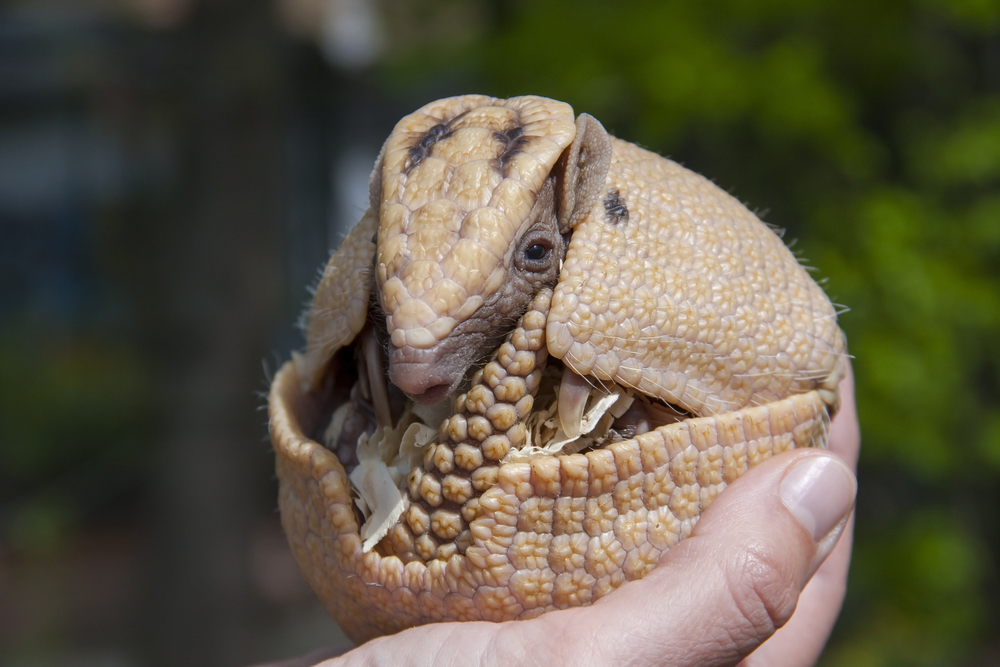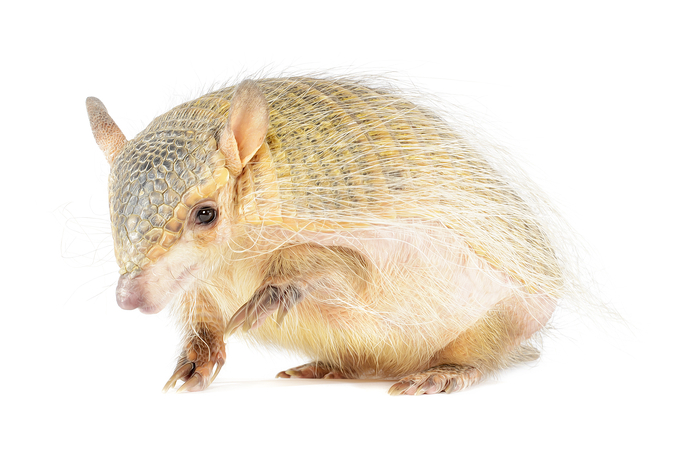Armadillo Facts

Armadillos are barrel-shaped animals covered with natural armor. In fact, its name in Spanish means “little armored one.” The armadillo’s armor works well against most predators, but not against cars. They are also known as the “Hillbilly Speed Bump” for their tendency to get run over by vehicles.
Size & Description
There are 21 species of armadillo, according to the Integrated Taxonomic Information System (ITIS). Some armadillos are very small, while others are huge. The smallest is the pink fairy armadillo, which is about 6 inches (15 centimeters) long. Giant armadillos are the largest species, and are about 5 feet (1.5 meters) long, according to National Geographic.
An armadillo's armor is made up of overlapping plates covering the back, head, legs and tail. The number of armored bands identifies the different species, according to the San Diego Zoo. Only one species, the three-banded armadillo, can roll itself into a hard armored ball to defend itself against predators. Other armadillo species simply dig a hole quickly and hunker down so that their tender stomach is protected and their armor is the only thing visible.
Armadillos have pointy snouts and long, sticky tongues, similar to anteaters, which are close cousins. Their eyesight is poor, so they hunt with a highly developed sense of smell. They also have wiry hairs along their sides and belly, which they use to feel their way around, like curb feelers on some cars. They also have strong legs and sharp claws for digging.
Habitat
Most armadillos stick to areas closer to the equator because they like temperate to warm areas due to their lack of fat stores. According to the Internet Center for Wildlife Damage Management, armadillos are very picky about where they live based on what type of soil is found in the area. Usually, armadillos prefer sandy or loam soils that are loose and porous. This makes digging for food and creating burrows easier.
All armadillos live in Central and South America, except for one species. The nine-banded armadillo ranges from Argentina to the southern United States, according to the Animal Diversity Web (ADW) at the University of Michigan. Since the mid-19th century, nine-banded armadillos have expanded northward. They have been seen in Florida and are now common in Missouri. In 2000, the body of a nine-banded armadillo was found in central Illinois, according to ADW.
Habits
Armadillos are not social creatures and spend most of their time sleeping. They usually sleep up to 16 hours each day in burrows, according to National Geographic. During the morning and evenings, they forage for food.
Usually, the only time armadillos get together is to mate or to keep warm. During cold times, a group of armadillos may hunker down in a burrow together to share body heat. Sometimes, a seven-banded armadillo will share its burrow with others of the same gender, though.
Diet
Armadillos are omnivores, which means they eat meat and plants, though 90 percent of an armadillo’s diet is made up of insects and larvae, according to the Internet Center for Wildlife Damage Management. With their long, sticky tongue, armadillos catch ants, beetles, termites and other insects after digging them out of the ground. They also eat plants, eggs, small vertebrates and some fruit. From time to time, they will scavenge for dead animals.

Offspring
After a gestation period of two to five months, the female will give birth to one to 12 young in a birthing burrow. These burrows can be up to 15 feet (4.5 m) wide, according to the Internet Center for Wildlife Damage.
Baby armadillos are called pups. According to the San Diego Zoo, twin births are common. Nine-banded armadillos have four identical pups of the same gender in every litter, and the seven-banded armadillo has eight to 15 identical pups at one time.
Pups mature quickly. They are weaned by two to four months. By nine to 12 months, the pups are mature and ready to have offspring of their own. Armadillos can live anywhere from four to 30 years. The median life expectancy for three-banded armadillos is around 16 years.
Classification/taxonomy
Here is the taxonomy of armadillos, according to ITIS:
Kingdom: Animalia Subkingdom: Bilateria Infrakingdom: Deuterostomia Phylum: Chordata Subphylum: Vertebrata Infraphylum: Gnathostomata Superclass: Tetrapoda Class: Mammalia Subclass: Theria Infraclass: Eutheria Order: Cingulata Family: Dasypodidae Subfamilies: Dasypodinae, Euphractinae and Tolypeutinae Genera and species: There are nine genera and 21 species, including:
- Dasypus novemcinctus — Nine-banded armadillo
- Dasypus septemcinctus — Seven-banded armadillo
- Calyptophractus retusus — Greater fairy armadillo
- Chaetophractus vellerosus — Screaming hairy armadillo
- Chlamyphorus truncatus — Pink fairy armadillo
- Euphractus sexcinctus — Six-banded armadillo
- Cabassous centralis — Northern naked-tailed armadillo
- Priodontes maximus — Giant armadillo
- Tolypeutes tricinctus — Brazilian three-banded armadillo
Conservation status
According to the International Union for Conservation of Nature (IUCN), armadillos are not endangered. Some species are vulnerable, though. For example, the Andean hairy armadillo is considered vulnerable because its population has declined by more than 30 percent in the past 10 years. The giant armadillo is considered vulnerable because its population has decreased by at least 30 percent in the past 21 years.
Other facts
Armadillos have a wide range of colors. They can be pink, red, black, gray or yellow.
Some people eat armadillos and claim it tastes like pork.
The nine-banded armadillo is the official state animal of Texas.
The giant armadillo can have up to 100 teeth, according to the San Diego Zoo.
The screaming hairy armadillo gets it name from the sound it makes when threatened. Don't get the idea that they are cowards, however. They have been known to throw their bodies on top of snakes, killing them by cutting them with the sharp edges of their shells, according to the San Diego Zoo.
Additional resources
Sign up for the Live Science daily newsletter now
Get the world’s most fascinating discoveries delivered straight to your inbox.











